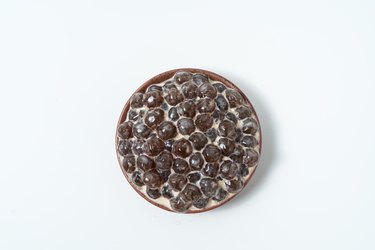
Tapioca isn't just for pudding these days. Perhaps because they're completely vegan and gluten-free, tapioca balls have begun to elbow thickeners like gelatin and flour out of the way in modern recipes for pies and other sweet treats.
Tapioca pearls are also the "boba" in that increasingly hip chilled drink known as boba tea. But whether you're making a honey boba recipe or an old-school tapioca pudding, it's important to know the best way to cook tapioca pearls for the perfect soft-chewy texture that makes them famous.
Video of the Day
Video of the Day
Understanding Tapioca Types
Tapioca products come from the cassava root. Tapioca balls, or pearls, come in different sizes and colors. Bigger-sized tapioca balls are used in boba tea, and they average about 8.5 mm. If you're making a honey boba recipe or another type of bubble tea, it will probably call for large black tapioca pearls. These have been mixed with brown sugar or caramel flavoring to give them their distinctive dark color and sweet taste.
Cooks select smaller, clear tapioca pearls for tapioca pudding. These tend to be smaller, at about 3 mm each. But this smaller size is now also used for "mini boba" tapioca balls of different colors and flavors, including strawberry and honey.
Along with various sizes of tapioca pearls, tapioca is also available in quick, or "minute," form for pie fillings and quick puddings. They cook more quickly because the cassava root has been dried and pulverized. Interestingly, once quick tapioca flakes cook, they form tiny pearls.
To Soak or Not to Soak
For recipes like tapioca pudding, recipes will most likely call for soaking the tapioca balls prior to adding them with the other ingredients. They don't need pre-cooking to get them to their chewy texture, because the pearls will get additional cooking once combined with the ingredients. It's best to follow the package instructions, but generally, even the smaller sizes require overnight soaking.
If you soak the tapioca pearls, do so for about 8 hours prior to cooking them. Use about three times as much water as the number of tapioca pearls you're using. Before you use the tapioca balls in your recipe, gently rinse and drain them.
Get (Pre) Cooking!
A treat such as a honey boba recipe specifies the need to pre-cook tapioca pearls instead of soaking. When the package or recipe calls for pre-cooking, you'll need about 7 parts boiling water to 1 part tapioca pearls.
Don't add the tapioca pearls until the water reaches a rolling boil. After you add them, stir the tapioca balls lightly, so they don't stick to the bottom or sides of the pan. The pearls should be floating on top while cooking to achieve the best texture. Stir them every few minutes; then take the pot off the heat after 15 minutes or so. (The package may specify a longer time, especially for bigger-sized pearls.)
Steeping and Draining
Tapioca pearls shouldn't be drained right away after coming off the heat. For the perfect chewy texture, allow them to steep for 15 to 20 minutes. Keep the lid on to retain the heat.
After the tapioca balls have steeped, gently empty them into a colander. Set them under cold or lukewarm water, and shake the colander to get as much of the rinse water off as possible.
Adding the Prepped Pearls
Whether you've chosen to soak or pre-cook tapioca balls as the initial step, you now have them at the best texture for the next phase. If you're making a honey boba recipe, for example, the tapioca pearls are mixed with honey and a simple syrup (sugar boiled with water) and left to soak for at least a half-hour. The boba pearls are now ready to be added to a glass of brewed floral tea, along with ice cubes, more simple syrup and cream.
When making tapioca pudding, add the soaked, uncooked tapioca pearls to the simmering milk-egg custard mixture that your recipe calls for, and whisk the pudding until it thickens. When the tapioca pearls turn completely clear, they're the perfect texture.
If you're using tapioca as a thickener in a pie, you probably won't be soaking or pre-cooking. Instead, the flakes or pearls are ground into a powder, added to the dry ingredients, then mixed with the fruit filling. For tapioca-based pies, the main "prep" is letting this blend set for about 10 minutes before placing it in a pie shell and baking, so the tapioca absorbs the fruit liquid.
- Epicurious: How to Make Bubble Tea
- Bubble Tea Supply: How To Prepare Tapioca Pearls For Bubble Tea
- Chowhound: The Boba Guys’ Jasmine Milk Tea with Honey Boba
- Epicurious: The Tricks to Tapioca, the Other Pie Thickener
- Serious Eats: How to Make Tapioca Pudding
- Happy Tea House Cafe: A look at the Different Types of Boba
- Gluten-Free Living: Tapioca